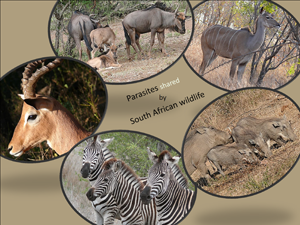Article contents
Some gastrointestinal nematodes and ixodid ticks shared by several wildlife species in the Kruger National Park, South Africa
Published online by Cambridge University Press: 04 February 2021
Abstract

Parasite surveys were conducted for 1–2 years in the Kruger National Park (KNP), South Africa on blue wildebeest, impalas, greater kudus, common warthogs and scrub hares. The host associations of some of the gastrointestinal nematode species infecting ≥60% of at least one of the five host species, were determined. These were Agriostomum gorgonis, Cooperia acutispiculum, Cooperia connochaeti, Cooperia hungi, Cooperia neitzi, Cooperioides hamiltoni, Gaigeria pachyscelis, Haemonchus bedfordi, Haemonchus krugeri, Haemonchus vegliai, Impalaia tuberculata, Longistrongylus sabie, Strongyloides papillosus, Trichostrongylus deflexus and Trichostrongylus thomasi. Although the prevalence of Trichostrongylus falculatus did not exceed 50% in any host species, it was present in all five hosts. Nematodes in the KNP range from those exhibiting strict host associations to generalists. Nematode-host associations may be determined by host feeding patterns and habitat use. Eight ixodid tick species were commonly collected from the same animals and in 2–3 year long surveys from plains zebras and helmeted guinea fowls: Amblyomma hebraeum, Amblyomma marmoreum, Hyalomma truncatum, Rhipicephalus appendiculatus, Rhipicephalus decoloratus, Rhipicephalus evertsi evertsi, Rhipicephalus simus and Rhipicephalus zambeziensis. Host specificity was less pronounced in ixodid tick species than in nematodes and the immature stages of five tick species infested all host species examined.
Keywords
- Type
- Research Article
- Information
- Copyright
- Copyright © The Author(s), 2021. Published by Cambridge University Press
References
- 7
- Cited by



